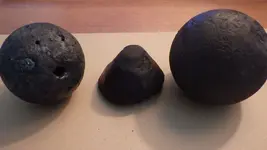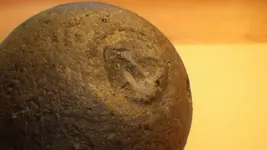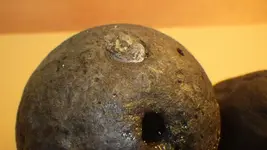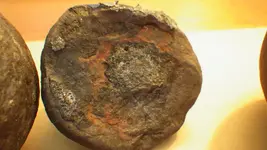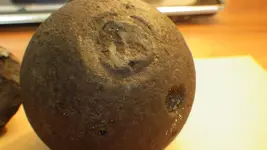The following is my testimony as a US-Government-recognized expert on civil war (and earlier) artillery projectiles, and a Professional Inerter/Deactivator of them for over 35 years. I've "Inerted" civil war shells for the US National Park Service. I've also taught Police Bomb Squad and ARMY EOD (Explosive Ordnance Disposal) classes about civil war artillery shells & fuzes, and how to Inert them.
Gtoast99 wrote:
> If a cannonball has powder in it, drilling it will KILL YOU.
False. Tens-of-thousands of cannonballs have gotten drilled, and in all the years since the end of the 1800s only one person has been killed during drilling a cannonball. (In 2008, a second person was killed when sparks from a grinder got into the (open) powder-chamber of a cannonball he was using the grinder on -- he was not drilling into it when it exploded.)
> Seriously. I'm not exagerating.
False. It is not my intention to embarrass you. But you've been mis-informed, and you are publicly repeating the mis-information -- which I feel obligated to correct for this forum's readers.
> Time underground doesn't inert the explosive capabilities of dug shells, even after centuries.
True. However, a century or more out in the weather in the soil does cancel the "shock-sensitivity" of civil war and earlier blackpowder. Unlike 20th-Century artillery shells, an EXCAVATED civil war or earlier shell will not explode due to being dropped, or even hammered-on. The proof: We relic-diggers have excavated over 100,000 pre-20th-Century shells. Nearly all of those got struck (hard) by the shovel during the digging process -- and there has not been a report of even one of them exploding due to the shovel's impact. Furthermore, relic-diggers are notorious for cleaning the rust/dirt-encrustation off of civil war shells by bashing on them with a hammer. Again, not a single explosion due to that hammering has been reported. The problem is that most people cannot tell the difference between a civil war shell and a 20th-Century shell -- and the latter is indeed "shock-sensitive."
All cannonballs are pre-20th-Century. Bullet-shaped shells can be either civil war era or a 20th-Century type.
> Civil War shells can and do still explode.
True. But as noted above, excavated civil war (and earlier) ones are not dangerous to drop. Extreme heat (570+ degrees Fahrenheit) was involved in every one of the VERY few explosions of civil war shells since the end of the 1800s.
> In fact, the breakdown of some of the powder creates a pressurized, explosive
> gas mixtures that is MORE dangerous than the powder itself.
The first part is true (Hydrogen Sulfide gas). The second part ("more dangerous") is false. The Hydrogen Sulfide gas forms when WATER gets inside the shell and interacts with the blackpowder. Wet powder of course will not burn or explode.
> Any tiny amount of heat inside the shell created by the drill can easily set it off.
False. The temperature Ignition Point for blackpowder is 572 degrees Fahrenheit. That is far more than a "tiny amount." The problem is that a spinning drillbit can go above 572 degrees in less than one minute.
> Disarming a shell is something that should ONLY EVER be attempted by a PROFESSIONAL
> with the PROPER SAFETY EQUIPMENT. A remote drill press, a water cooling system, etc.
> If you don't know what you need to do it safely, you shouldn't be doing it.
All true!
In summary... it's not worth your life (or even your fingers) to try to save some money by doing Inerting of an artillery projectile yourself. Please contact a Professional Inerter/Deactivator. (Note, the police will automatically destroy any shell you call them about.) My main point in posting all the above information is to clear up myths and exaggerations about EXCAVATED CIVIL WAR AND EARLIER artillery projectiles. Those kinds are not dangerous to merely handle, or dig up, or carry in your car. If you are not sure about the time-period of an artillery projectile, post it here in the What-Is-It forum for definite identification.
 )
)